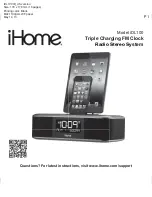
WI-MOD-9-D
Radio Modem
User Manual v1.9
WI-MOD-9-D
Manual
v 1.9
Page
30
probability of two devices using the same channel is small, and if this does occur, the
probability of sharing the same channel on a re-transmission is extremely small.
There is a higher chance of interference from other WI-MOD-9-D systems. Because WI-MOD-
9-D are designed to operate in a peer-to-peer network, without a “master module” directing the
communications, each WI-MOD-9-D will scan the radio band looking for other WI-MOD-9-D
messages. The WI-MOD-9-D radio message has a unique “signature” to separate it from radio
messages from other devices. A WI-MOD-9-D in one system will “hear” other WI-MOD-9-D
systems, and this can be a cause of interference.
In countries which allow the full 902-928MHz band (such as USA and Canada), there are eight
hopping sequences, and the first four do not use the same frequency channels as the last four -
this can give isolation between two systems. That is, a system with hopping sequence 1 will
hear messages from another system using hopping sequence 3, but will not if the other system
used hopping sequence 5. The hopping sequence is determined by the system address. In
countries which only allow half the band (such as Australia and New Zealand), it is not possible
to separate systems in this way because the band is smaller and all hopping sequences use all
channels available.
It is possible to separate systems by changing the message “signature”. A WI-MOD-9-D will
not lock onto a message with a different signature and will ignore the message as RF noise.
There are four different message signatures available - this is user configurable in register S21 -
refer section 4 of this manual.
This feature was introduced with firmware version 1.90. Earlier firmware versions only support a
single fixed message signature. The Firmware version may be read from the module using the
configuration software provided with the module, or by reading the serial number.
The firmware version is written in digits 5 through 7 of the serial number, so a module with
serial number 0804 187 9469 has firmware version 1.87, which has a single fixed message
signature, while serial number 0105 190 2345 has firmware version 1.90, with configurable
message signatures.
Note: If you are adding a new WI-MOD-9-D to an existing system with older modules, you will
need to set configuration register S21 to 0 to make it compatible with the older modules.
3.10
Operating Problems
Most operating problems relate to an inadequate radio path, or radio interference. Before
installing a system, bench test the complete system with the WI-MOD-9-D units near each
other. This test eliminates the radio path or interference as a factor, and ensures that the system
will operate in the way that you want. It is not necessary to connect antennas, however a small
length of wire should be inserted into the middle pin of the coaxial connector - this will act as
an antenna.
If the bench test does not give adequate performance, then you need to adjust the configuration
parameters. We recommend that you do not install the system until you are happy with the bench
test performance.
















































